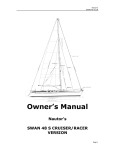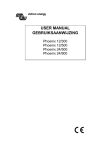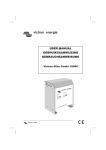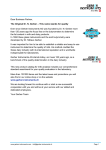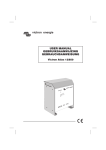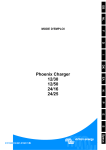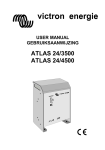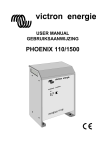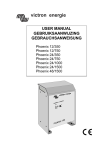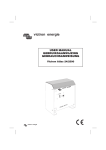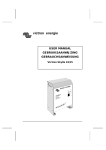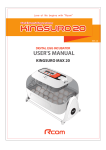Download Atlas Combi 12/450
Transcript
victron energie USER MANUAL GEBRUIKSAANWIJZING GEBRAUCHSANWEISUNG Victron Atlas Combi 12/450 victron energie victron energie SECTIONS English Nederlands Duits victron energie This page intentionally left blank. 4 user manual victron energie ENGLISH USER MANUAL Victron Atlas Combi 12/450 victron energie user manual 5 This page intentionally left blank. Subject to change without notice. 6 AC09001E / 021095 / RV D user manual victron energie INTRODUCTION Victron Energie has established an international reputation as a leading designer and manufacturer of power systems. Our R&D department is the driving force behind this reputation as it is continually seeking new ways of incorporating the latest technology in our products. Each step forward results in value-adding technical and economical features. Our proven philosophy has resulted in a full range of state-ofthe-art equipment for the supply of electrical power that meets the most stringent requirements. Victron Energie systems provide you with high-quality AC supplies in places where there are no permanent sources of mains power. An automatic stand-alone power system can be created with a configuration comprising a Victron Energie inverter, battery charger, mains manager (if required) and, last but not least, batteries with sufficient capacity. Our equipment is suitable for countless situations in the field, on ships or other places where a mobile 230-Volt AC power supply is indispensable. Victron Energie has the ideal power source for all kinds of electrical appliances used for household, technical and administrative purposes, including instruments susceptible to interference. All of these applications require a high-quality power supply in order to function properly. Victron Atlas Combi 12/450 This manual contains directions for installing the Atlas Combi model 12/450. It describes the functionality and operation of the Atlas Combi, including its protective devices and other technical features. victron energie user manual 7 This page intentionally left blank. 8 user manual victron energie CONTENTS 1. 2 3. 4. DESCRIPTION 7 1.1 1.2 1.3 1.4 1.5 1.6 7 7 8 8 9 9 General Victron Atlas Combi The battery charging section The inverter section Changeover Charging PROTECTIVE DEVICES 11 2.1 2.2 2.3 2.4 2.5 2.6 2.7 11 11 11 12 12 12 12 Short-circuits Maximum power Overload Temperature Low input voltage High input voltage Reversed polarity INSTALLATION 13 3.1 3.2 3.3 13 13 13 13 14 14 14 15 Materials required Location Connections 3.3.1 Earth 3.3.2 230 VAC output 3.3.3 230 VAC input 3.3.4 Battery 3.3.5 Battery cables START-UP 17 4.1 4.2 4.3 4.4 17 18 18 18 18 19 19 20 20 20 20 21 22 22 22 23 23 24 Operation “On” position “Stand by” position Changeover 4.4.1 Engaging 230 V mains 4.4.2 Disengaging 230 V mains 4.5 Charger 4.6 Adjustments 4.6.1 Frequency 4.6.2 Output voltage 4.6.3 Switch-on sensitivity on “stand by” 4.7 Battery charger 4.7.1 Adjustment of voltage 4.7.2 Float 4.7.3 Equalize 4.8 Maintenance 4.9 Jumpers 4.10 Potentiometers victron energie user manual 9 5. 6. FAULT TRACING LIST 25 5.1 5.2 5.3 5.4 5.5 5.6 25 25 26 27 27 27 SPECIFICATIONS 29 6.1 29 29 29 30 30 30 30 31 31 6.2 6.3 7. 10 General The inverter fails to start The (unloaded) AC output voltage is too low The battery charger fails to start The batteries overcharge The batteries do not charge fully Inverter 6.1.1. Input 6.1.2. Output 6.1.3. Automatic Economy Switch (AES) Battery charger 6.2.1 Input 6.2.2 Output 6.2.3 Changeover Mechanical data DRAWINGS 33 Atlas Combi 12/450 cabinet dimensions 34 user manual victron energie 1. DESCRIPTION 1.1 General Victron Atlas Combi 12/450 units are tested to ensure correct functioning before leaving the factory. They are packed in shock-absorbing polystyrene and packed in sturdy cardboard boxes for secure transportation. Along with the equipment itself, the box also contains a manual. IP21= protection against materials larger than 12 mm (for example a finger) and protection against vertically descending waterdrops (condensation). Watt = unit of power Volt = unit of voltage Volt rms = root mean square (effective value of alternating wave) Hertz = unit of frequency victron energie The Victron Atlas Combi is housed in a robust aluminium cabinet (IP21) suitable for floor or wall mounting. The AC output terminals and the DC battery terminals are located on the front of the cabinet. 1.2 Victron Atlas Combi 12/450 The Atlas Combi is a compact combination of an inverter and an automatic battery charger, hence the name Atlas Combi. The coding of the Combi models is composed as follows: example: Atlas Combi 12/450: 12/ = /450 = 12 Volt, battery voltage 450 Watt, continuous power The Atlas Combi delivers a modified sinewave alternating current of 230 V, 50 Hz. Continuous power can be delivered at all times. A maximum short-duration power can be delivered for about one second: at a battery voltage of 12 Volt, the maximum power is 700 Watt. Almost any electric or electronic device powered by a 230 VAC (50 Hz) supply may be connected to the inverter of the Atlas Combi. user manual 11 1.3 The battery charging section The battery charger of the Atlas Combi is suitable for a 230 V (50 Hz) mains voltage. The charger works automatically and delivers a maximum current of 25 amp. The battery may remain permanently connected to the charger, even during winter storage. The Atlas Combi is suitable for starter batteries and semi-traction batteries of the lead/acid type in open or sealed designs. starter battery = 1.4 The inverter section The inverter converts a direct current of 12 V into an alternating current of 230 V, 50 Hz (see illustration 1). With the Atlas Combi switched on (i.e. switch set to “on”) the inverter’s own no-load power consumption is 14 Watt. a battery used only to start machines (such as the engine of a boat) and suitable for high cold currents semitraction A full-load efficiency of approximately 85% is achieved through the use of FET transistors. battery = a combined starter/light battery The Atlas Combi has an AES (“Automatic Economy Switch”), as standard. It is activated by setting the switch to the “stand by” position. The AES switches the inverter off when the external equipment does not require power. This limits power consumption to 2 Watt and the inverter operates when a load is detected. Substantially reduced power consumption is achieved when there are intermittent loads. The sensitivity of the AES can be adjusted, for more information see section 4 “Start-up”. Illustration 1. Outputvoltage waveform during “on” mode. 12 user manual victron energie 1.5 AES = Automatic Economy Switch intermittent load = a load regularly switched on and off automatically in equipment such as refrigerators or electric heaters with thermostats. Changeover When a mains voltage is connected to the Atlas Combi, the “on” LED goes out. The load of the inverter is automatically switched to mains after about 1 second. As a result, the inverter is immediately switched off. More information about this changeover is given in section 4.4. 1.6 Illustration 2. Output voltage waveform during “AES” mode. Charging The automatic part of the charger starts up about 1 second after the charger switch has been set to the “on” position and 230 VAC is present. Charging takes place according to the WoUoU characteristic, with a maximum current of 25 amp at a battery voltage of 12 V. The boost charging voltage is set to a standard value of 14.25 VDC (see illustration 3). AC = Alternating Current. This is the normal type of voltage supplied by the mains or shore power systems DC= Direct Current. This is the type of Voltage deliverd by batteries and battery chargers. Illustration 3. Charging current waveform in relation to battery voltage. victron energie user manual 13 This page intentionally left blank. 14 user manual victron energie 2. PROTECTIVE DEVICES The Atlas Combi is extremely reliable thanks to numerous built-in protective devices. Descriptions of these devices are given below. 2.1 Short-circuits The inverter’s output is protected against short-circuiting. For the Atlas Combi 12/450, the short-circuit output current amounts to 3 amp. short circuit current = current supplied when a shortcircuit on the output occurs. In this condition the output voltage approaches 0 V. Once the short-circuit has been rectified the inverter immediately resumes normal operation. This eliminates the need to fit a fuse in the inverter’s output circuit. 2.2 Maximum power The maximum power which can be delivered by the inverter is 700 Watt. This level, which is limited electronically, can be delivered for several seconds. If the equipment is overloaded for too long, the input plate fuse (50 A) will become defective. 2.3 Overload If the inverter is subjected to a high load, it may reach the critical limit and the overload protection will be activated. With the Atlas Combi 12/450 this critical limit is ca. 600 Watt. The overload protective device fitted to the Atlas Combi 12/450 works as follows: LED = Light Emitting Diode victron energie ❐ When the critical limit is reached, the “overload” LED lights up. Although the inverter will not switch off, the output voltage will fall as the load increases. ❐ When the overload situation has ended, the voltage will automatically return to the correct level. user manual 15 2.4 Temperature The temperature of the electronics is measured continuously. The inverter switches off before the temperature reaches an unacceptably high level due to short-circuiting, overloading or excessive ambient temperatures. The “temperature” LED lights up when this situation occurs and the inverter restarts automatically once the temperature has dropped to an acceptable level. 2.5 Low input voltage The inverter switches off if the input voltage is too low. This input voltage limit is 9.0 V. The inverter restarts when this voltage exceeds +10.5 V. 2.6 High input voltage The inverter switches off if the input voltage rises above 17 V and restarts once the input voltage has dropped below +15 V. 2.7 Reversed polarity If the positive (“+”) and negative (“-”) poles are switched when the equipment is being connected up, the inverter will not switch on. Once this has been corrected the inverter will switch on. You should therefore follow the connection instructions given in section 3.3.4, on page 18 very carefully. input voltage = DC voltage delivered by batteries output voltage = AC voltage delivered by the Victron product 16 user manual victron energie 3. INSTALLATION 3.1 Materials required ❐ ❐ ❐ Two mains leads, 1.5 mm2, maximum length 6 m. Battery cables. The Atlas Combi model 12/450 is fitted with a mains lead, so a screwdriver is not required. 3.2 Location ❐ Install the inverter in a dry area with good ventilation. Note: High ambient temperatures will reduce output power, impair efficiency and shorten working life (see section 6 “Specifications”). There are holes in the bottom and rear of the cabinet for floor or wall mounting. For the dimensions, refer to section 7 “Drawings”, page 38. Install the Atlas Combi in an upright position with sufficient space for natural cooling through the grill of the cabinet. If this is not possible forced cooling must be provided by fitting a fan to the underside. Make sure you will have easy access to the front of the unit after installation. Keep the distance between the Atlas Combi and the battery as short as possible. ❐ ❐ ❐ ??? 3.3 Connections 3.3.1 Earth Connect the mains earth wire to the earth contact of the socket. The circuit is functional only if the cabinet is connected to earth. An M5 earth screw is fitted on the front of the cabinet (see illustration 4, on page 19). Connect the cabinet earth terminal to earth. The earth for vessels is the hull or earth plate; for motor vehicles it is the chassis. 3.3.2 230 VAC output The Atlas Combi 12/450 is fitted with a socket, which is located on the front, at the lower left-hand side (see illustration victron energie user manual 17 3 on page 19. The 230 V external equipment must be connected to this socket. It is not necessary to incorporate a fuse in the inverter’s output: the inverter is fully protected against overloading and short-circuiting, see section 2, “Protective devices”. The inverter will be damaged if another alternating current (e.g. from a generator) is connected to the 230 V output, however briefly. This also applies when the inverter is switched off (“off” position). 3.3.3 230 VAC input A 230 VAC supply is needed if the Atlas Combi’s battery charger is used. Use the three-wire cable (wire diameter 1.5 to 2.5 mm2) which is supplied with the equipment. The connection arrangement of the input terminal block is in the same order as the output terminal block (see illustration 9). This cable should be connected to the terminal situated to the right of the socket (see illustration 4 on page 19. Ensure that double-pole switches are used for all switching between different 230 VAC power supplies (e.g. generator), otherwise the Atlas Combi may be damaged. 3.3.4 Battery The functioning and working life of equipment and batteries depend on the battery connections being made correctly. Between the battery and the Atlas Combi there is a circuit with a low voltage and high current. Resistance decreases accordingly as cables become shorter and thicker. The combined resistance of the two cables must not exceed 4 milliohms. double-pole switching switching by means of a relay which has two separate contacts, i.e. one for phase The terminals to which the battery cables are connected are located on the front of the Atlas Combi, at the lower left-hand side (see illustration 3). The terminals are suitable for use with battery cables which have a flexible core. 18 user manual victron energie 3.3.5 Battery cables In determining the wire diameters of the battery cables, loads of 450 Watt and peak loads were taken into account. Distances to batteries cable diameter less than 1.5 m 6 mm2 more than 1.5 m and less than 6.0 m 10 mm2 Avoid contact resistances by tightening up all connections. Illustration 4. Atlas Combi 12/450 connections victron energie user manual 19 This page intentionally left blank. 20 user manual victron energie 4. START-UP 4.1 Operation The switches and monitoring LEDs of the inverter are located on the front of the Atlas Combi (see illustration 5). LED’s on stand by charge overload switched on inverter operating automatically battery charger on overload indication input battery voltage too high input ⊕ battery voltage too low temperature inverter temperature too high inverter switch inverter inverter on switched on off switched off stand by stand by battery charger switch charger battery charger on switched on off switched off Illustration 5. Atlas Combi 12/450 front. victron energie user manual 21 4.2 “On” position Start the inverter by setting the “inverter” switch to the “on” position. The “on” LED lights up if an output voltage is present. 4.3 “Stand by” position When the inverter is in the “stand by” mode (bottom position of the switch), the “stand by” LED lights up to indicate that the AES has been activated. Refer to section 5 “Fault tracing list” if this does not occur. The inverter starts as soon as the load at the output exceeds 9 W. This causes the “on” LED to burn more brightly, while the “stand by” LED remains at normal brightness. The inverter switches back to the “stand by” mode automatically as soon as the load is switched off. This enables considerable energy savings to be achieved. The switch-on sensitivity of the AES can be adjusted using potentiometer R82 (for more details, see section 4.6.3.). 4.4 Changeover 4.4.1 Engaging 230 V mains If the Atlas Combi 12/450 is connected to the 230 V mains, the following sequence of events will occur: The inverter switches off. The connected load (maximum 600 Watt) is switched from the inverter to the mains network. The “on” LED lights up. The equipment’s plug contains a 6,3 amp glass fuse, which protects the changeover contacts (see illustration 6). Illustration 6. Location of mains glassfuse. 22 user manual victron energie 4.4.2 Disengaging 230 V mains If the 230 V mains voltage is switched off, the following sequence of events will occur: The load is switched to the inverter. The inverter starts immediately. The external equipment is reconnected to a 230 V supply within 0.5 seconds. The “charge” LED goes out and the battery charger is switched off. 4.5 Charger The charger of the Atlas Combi is switched on by setting the “charger” switch to the “on” position. The “charge” and “on” LEDs light up after about 0.1 seconds. The voltage rises gradually until it reaches 14.25 V, depending on battery capacity, discharge and consumption. When the battery reaches a voltage of 14.25V, the charging current drops. This high charging current is maintained for four hours, thereby ensuring optimum charging of the batteries. After this period the charger switches to a lower voltage of 13.5 V. V.D.L. = Victron trickle charge system float charge mode = The battery charger works with the VDL 2-step charging system made by Victron Energie. It automatically keeps the battery in a perfectly charged condition for extended periods. External equipment has immediate access to power. recharging boost charge mode = initial charging If, during the float charge cycle, the voltage drops below 13.5 V for longer than 30 seconds, a new boost charge cycle is started. This may occur after the switching on of external equipment which requires more than 25 amp. A new “boost equalize - float” cycle is also started if the charger is switched off briefly. With the VDL system, the battery can remain permanently connected to the battery charger, without overcharging. victron energie user manual 23 4.6 Adjusting the inverter Frequency and output voltage can be adjusted with the aid of potentiometers. General information about potentiometers can be found in section 4.10. Open the cabinet by unscrewing the four screws (M4) off the dripshield. Take the dripshield off and unscrew the four cap nuts on the front, then remove the front (see illustration 7). The adjustment points are on the control PCB of the inverter. This PCB, which is located at the front of the subchassis, contains three adjustment points, namely: potentiometers P3 (output voltage), P4 (frequency) en R82 (AES-sensitivity). See illustration 8. Illustration 7. Removal of the frontpanel. 4.6.1 Frequency The frequency is set to a standard value of 50 Hz although this can be altered by turning potentiometer P4 (see illustration 7) to the left (“-”) or to the right (“+”). This can be measured with a digital frequency meter. 4.6.2 Output voltage The output voltage is set to a standard value of 220 VRMS at a load of 450 Watt and an input voltage of 12 V. The unloaded output voltage is approximately 233 VRMS. The output voltage may be adjusted by turning potentiometer P3 (see illustration 7) to the left (“-”) or to the right (“+”) (the standard factory-setting is 233 Volt). frequency meter = device for measuring the frequency of the mains voltage 4.6.3 Switch-on sensitivity on “stand by” If the inverter fails to start when the external equipment requests power, the AES sensitivity may be increased by turning potentiometer R82 to the right. Check whether the inverter returns to “stand by” once the external equipment has switched off. 24 user manual victron energie Illustration 8. Location potentiometers P3 and P4. 4.7 Adjusting the battery charger The adjustment points are on the control PCB of the battery charger. The control PCB of the battery charger, which is located beneath the rear of the sub-chassis, has two adjustment points; potentiometers P1 (equalize) and P2 (float) (see illustration 9 and page 39, drawing ac02050i). Illustration 9. Location of potentiometers P1, P2 and R82. victron energie user manual 25 4.7.1 Adjustment of voltage The battery charger operates with two charging voltages which must be adjusted separately. First set the low charging voltage (float) and then the high charging voltage (equalize). Internal adjustments should only be carried out by a qualified technician. 4.7.2 Float The following procedure should be used when adjusting the low charging voltage (float) by means of potentiometer P2 (see illustration 8). step 1 Switch on the charger and disconnect all external equipment. step 2 Using an acidimeter, check whether the batteries are fully loaded. step 3 Position jumper S1 (see illustration 9). For further information about jumpers see section 4.9. step 4 Connect a voltmeter with a reading accuracy of 0.1 V to the output of the charger. Adjust the float charging voltage (potentiometer P2) until the required voltage has been achieved (13.5 Volt). step 5 Remove jumper S1. step 6 Seal the adjusting screw of potentiometer R4 with nail polish. Jumper Function S1 float test S2 (pins 1+2) charging time 8 hours S2 (pins 2+3) charging time 4 hours (standard setting) 4.7.3 Equalize The high charging voltage (equalize) is adjusted once the low charging voltage (float) has been set. The following procedure should be used for adjusting the high charging voltage with the use of potentiometer P1 (see illustration 9): step 1 step 2 26 Switch on the charger. Wait until the batteries are charged to a level where the charging current is below 5 amp. Connect a voltmeter with a reading accuracy of 0.1 V to the output of the charger. user manual victron energie step 3 step 4 Adjust the equalize voltage (potentiometer P1) until the required voltage has been achieved. Seal the adjusting screw of potentiometer P1 with nail polish. Internal adjustments should only be carried out by a qualified technician. 4.8 Maintenance The Atlas Combi does not require any special maintenance. It is advisable to check the electrical connections periodically (once a year). Keep the converter as dry and clean as possible. 4.9 Jumpers Jumpers are small removable connectors situated on the PCB. By placing and removing the jumpers various features can be enabled or disabled. Illustration 9 shows how to set the jumpers. Illustration 10. Placing the jumper. victron energie user manual 27 4.10 Potentiometers Potentiometers are adjustable resistors. Turning the screw increases or reduces the values associated within the potentiometer. These values may concern matters such as voltage, frequency or switch-on sensitivity. The screw must be turned by means of a screwdriver (No. 0) and sealed with Tipp-Ex or nail polish. See also illustration 10. Illustration 11. Potentiometer. 28 user manual victron energie 5. FAULT TRACING LIST 5.1 #@ & grr 1 @$6 48?!! >v %/J s!!?" f% General This list of steps will facilitate the rapid tracing of the most common types of faults. Before you start you must: ❐ connect the mains supply to the charger; ❐ disconnect all 12 V external equipment from the battery. Several fault situations are described below: ❐ the inverter does not start; ❐ the AC output voltage is too low; ❐ the charger does not start; ❐ the battery overcharges; ❐ the battery does not charge or does not charge fully. 5.2 step 1 step 2 step 3 victron energie The inverter fails to start Set the “inverter” switch to the “on” position and check whether the green “on” LED lights up. Go to step 2. The following may occur: ❐ The green “on” LED lights up and the Atlas Combi produces only a “buzzing” noise; go to step 3. ❐ The green “on” LED lights up and the “overload” LED lights up after a few seconds; go to step 3. ❐ The green “on” LED lights up and the “battery low” LED lights up; go to step 4. ❐ The green “on” LED does not light up; go to step 8. Remove the load from the AC output and check whether the “overload” LED goes out when the inverter is switched on. If it does not, go to step 8. user manual 29 step 4 step 5 step 6 step 7 step 8 5.3 step 1 step 2 step 3 30 Check the input voltage of the battery on the terminals of the Atlas Combi. The input voltage should lie between 10.5 Volt (minimum) and 15 Volt (maximum). If the input voltage is not between the minimum and maximum values, check the plate fuse. If this is intact, go to step 5. If the input voltage is correct, go to step 7. Check whether the 12 V connecting cables are properly connected and the wires are of a sufficient diameter. Rectify the situation if the connecting cables are not properly connected or the wire diameters are not in conformity with the specifications. Also, check that the terminal screws are securely tightened. If this action does not solve the problem, go to step 6. The battery must be charged. Go to step 7 if the battery has been sufficiently charged or recharged but the inverter does not start. Check whether the plus (“+”) and minus (“-”) of the battery and the Atlas Combi correspond. Go to step 8. Contact your Victron Energie dealer to have the Atlas Combi repaired. The (unloaded) AC output voltage is too low If you have determined with an RMS voltmeter (moving-iron voltmeter) that the AC output voltage is too low, go to step 2. Turn potentiometer P3 (see section 4.6 “Adjustments”) to the right and check whether the voltage returns to the normal value. If it does not, go to step 3. Contact your Victron dealer to have the Atlas Combi repaired. user manual victron energie 5.4 step 1 step 2 step 3 step 4 5.5 step 1 step 2 step 3 5.6 step 1 step 2 victron energie The battery charger does not start Turn on the charger by setting the “charger” switch to the “on” position. If the “charge” LED lights up but the “on” LED does not, go to step 2. Turn off the 230 V mains supply. Check the glass fuse. This is located towards the front of the cabinet (see illustration 5). If the fuse is in order, go to step 4. If the fuse is defective, proceed to step 3. Replace the defective fuse. Reconnect the 230 V mains supply to the Atlas Combi. The problem has been solved if the fuse operates normally. If it becomes defective again, go to step 4. Contact your Victron Energie dealer to have the Atlas Combi repaired. The batteries overcharge Check the battery voltage. Go to step 2. If the battery voltage is about 14.25 V, contact the manufacturer of the battery because the battery is probably defective. If so the battery must be replaced. If the voltage is higher than the above values, go to step 3. Then check the jumpers. Contact your Victron Energie dealer to have the Atlas Combi repaired. The batteries either fail to charge or do not charge fully Check whether the cables to the batteries are properly connected to the battery terminals. Repair these connections if the contacts are defective. If this does not solve the problem, go to step 2. Check that the mains voltage (or generator voltage) is adequate, check for voltage losses in cables, (overly) long cables, etc. If necessary, the appropriate manufacturer should be consulted. If this input voltage is higher than 209 VAC, go to step 3. If the input voltage is lower than 209 VAC, go to section 6.7. user manual 31 step 3 step 4 step 5 32 Allow the Atlas Combi to charge continuously for about eight hours with the 12 V external equipment switched off. The problem has been solved if after this period the battery voltage is ca. 14.25 V. If this voltage is lower, go to step 4. Check whether too many pieces of external equipment are connected to the Atlas Combi and check the batteries for: ❐ defective cell(s); ❐ a maximum capacity of 250 a.h. If the batteries are in proper working order, go to step 6. Any batteries not meeting the specifications, must be replaced. After replacement, go to step 5. Check the charger again. The problem has been solved if the charger works properly. If it does not, go to step 6. user manual victron energie 6. SPECIFICATIONS 6.1 Inverter 6.1.1 Input Nominal input voltage: Input voltage range: Voltage ripple: Nominal input current: Maximum input current: No-load in “auto” mode: No-load in “on” mode: 12 VDC 9 - 17 VDC maximum 5% RMS 40 amp 60 amp 2 Watt 14 Watt 6.1.2 Output Output voltage: Frequency: Waveform of output voltage: Power factor: Power at -10 to +40°C: Power at -10 to +25°C: Power at -10 to +45°C: Power at -10 to +50°C: Switch-on behaviour: Efficiency: Dynamic stability: Overload protection: Short-circuit protection: victron energie user manual 230 VAC; ± 5% 50 Hz; ± 5% modified sinewave 0.9 capacitive to 0.4 inductive 300 Watt, power factor 0.8 450 Watt, power factor 1 275 Watt, power factor 1 215 Watt, power factor 1 The inverter can start under any load conditions. The nominal output voltage is reached in 50 msec. 80% Maximum surges of 10% when switching on and off at 50% nominal load. Recovery time is 1⁄ period. 2 The delivered power is limited electronically to: 200% of the continuous power at the nominal input voltage. The output is short-circuit proof. The short-circuit current is ca. 3 Ampere 33 Ambient temperature protection: High/low input voltage protection: Sensors measure the temperature of critical components. The sensors switch off the inverter if the temperature on the FETs rises above 80°C and/or the transformer temperature rises above 110°C. The inverter restarts automatically after the components have cooled down. The inverter switches off automatically at values above 17 VDC and below 9.5 VDC. 6.1.3 Automatic Economy Switch (AES) Switch-on: Adjustable sensitivity: Switch-off: Test voltage on “auto”: 6.2 9 Watt 2 - 48 Watt 1 Watt 60 VRMS 50 Hz Battery charger 6.2.1 Input Nominal input voltage: Frequency: Input voltage range: Input voltage fuse 230/240 V: Power factor: 230 VAC 48 - 62 Hz ± 10% 1 x 6,3 amp fast; 5 x 20 mm 0.7 inductive 6.2.2 Output Nominal charging voltage: Charging voltage float boost Charging characteristic: Adjustable range: Voltage stability: Output current: Current ripple: Current stability: 34 12 VDC 13.5V 14.25V WUOUO according to DIN 41772 13.0 - 15.0 V 1% 25 amp 70% RMS 5% approx. user manual victron energie 6.2.3 Changeover Maximum switching capacity: Changeover time: Breakdown voltage of output to earth: Insulation resistance: input and output to earth: input and output mutually: Safety class EMC: Electro-magnetic compatability according Council Directive 89/336 EEG Emission: Immunity: 6.3 100 M ohm 500 VDC 100 M ohm 500 VDC IEC 950 (I. PCB) EN 55014 (1993) EN 60555-2 (1986) EN 50082-1 (1991) Mechanical data Cabinet: Colour: Dimensions (H x W x D): Weight: Noise level: Connecting points: Output 230 VAC: Input 12 VDC: Charger: Input 230 VAC Earth Cooling: Relative humidity: victron energie 600 Watt 0.5 sec. 2.5 kV; 50 Hz user manual Aluminium IP21 Blue (RAL 5012), epoxy 280 x 200 x 180 mm 11 kg 40 dB(A) Mains socket at front 10 mm2 terminals on front Equipment euro socket M5 screw Natural cooling maximum 95% 35 This page intentionally left blank. 36 user manual victron energie 7. DRAWINGS victron energie Victron Atlas Combi 12/450 cabinet dimensions 38 Victron Atlas Combi 12/450 print 39 user manual 37 38 user manual victron energie victron energie user manual 39 40 user manual victron energie








































